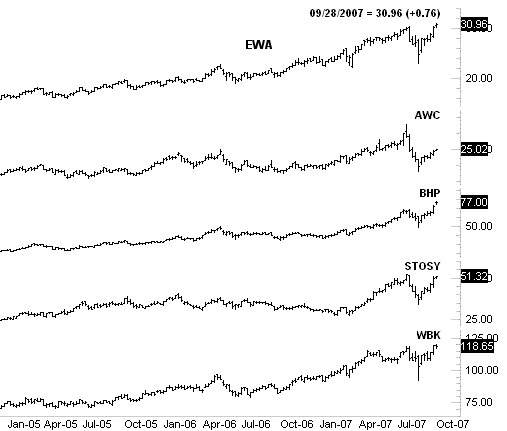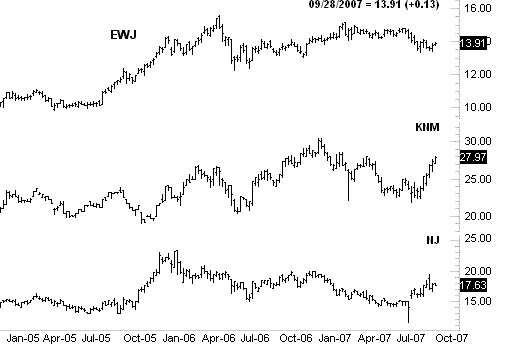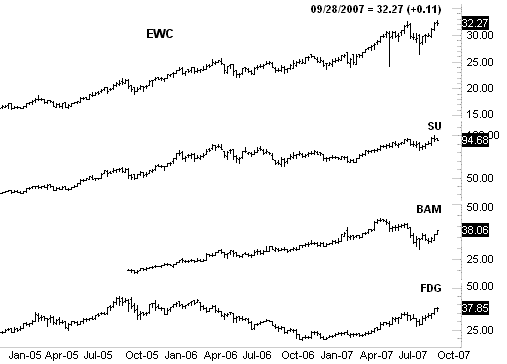|
A Picture Is Worth a Thousand Words
Here's one more-geared for the investor side of our fan base, as opposed to the trader side. After all, even though our focus is on swing trading and option trading, portfolio balance (between risk, reward, and volatility) is still crucial if you want to have any longevity in this game.
Previously, we detailed a trend that may have been off of most everybody's radar. As Jim Cramer says, "There's always a bull market somewhere," and in this case, it looked like Russia had one in place.
As a basic proxy for the Russian stock market, Van Eck Global has recently created a Russian ETF (RSX). At the time, RSX was at 40.27. As of Tuesday, it's at 44.55, a 10.6% gain. Not gigantic, but not chump change either, especially considering the U.S.-based S&P 500 is basically flat for the same timeframe. Oh don't get me wrong, the Russian market also faltered in July and August just like most every other market did at the time. It's just that Russian stocks held their ground a little better, and did a little better with their recovery.
As for the stocks we picked out, for the most part they led the pack. Mobile Telesystems (MBT) is up 14.5% since then, MMC Norilsk (NILSY) gained 25.8%, Wimm Bill Dann Food (WBD) is up 30.9%, while Rostelecom (ROS) is up 10.7%. We knew it may have been a hot spot, but we had no idea these stocks were going to get that kind of result.
As a result of the kind of success we saw here, we've started looking at ADRs a little more closely. In fact, we've actually traded a few in our subscription services with some pretty good success so far. Our Multi-Cap-Growth Portfolio is up 20.9% on a position in Acergy (ACGY), and the NetLetter stock portfolio is sitting on a 12% gain in Telefonica (TEF).
Though there are only a few liquid ADRs, and even fewer with options traded on them, I really like the way these stocks are able to trade a little independently of the U.S. stocks we've watched for years. What I find a little ironic is this...while the consensus is that adding international exposure to your portfolio (trading or investing) is supposed to increase your volatility, I think we've seen quite the opposite.
Needless to say, I plan on using ADRs - albeit selectively - going forward. Whether you're a subscriber or not, I think they may offer you an advantage as well.
Anyway, with our new-found love for international equities now firmly established, there are a couple of other big trends I'm seeing at the international level.
Australia
The land down under has been resilient for years now. The iShares MSCI Australia Index (EWA) is up 163% over the last four years, and I see no signs of long-term growth slowing down. As far as timing goes though, I think now may be one of the worst times to jump in. Why? These stocks are up an average of 32.2% since their reversal on August 15, and are well into overbought territory. A pullback may be worth waiting on.
One of the challenges you'll find with Australia is a fairly limited number of decent-looking ADRs. The only ones of any real interest to me were Alumina (AWC), BHP Billiton (BHP), Santos (STOSY), and WestPac Banking (WBK). This makes the iShares ETF slightly more attractive, even though the biggest gains in the ADR world are with individual stocks.
Select Australian Stocks

Japan
Japanese stocks have been lagging for a long time now. The iShares Japan Index Fund (EWJ) slightly down for the year, and the last two months have been particularly unkind. Things change though. On the other hand, this is more of a trading point of view than an investment point of view.
In the Japanese bear's defense, I saw a lot of sharply down-trending stocks here. Advantest (ATE), Hitachi (HIT), Mitsubishi (MTU), Nippon (NTT), Sony (SNE), and even Toyota (TM) are all in pretty bad trouble.
Even so, many of these stocks (and the ETF) just looks plain oversold. Besides, the best of the best don't necessarily mirror the rest of the crowd. Take Konami (KNM) for instance. It's racing higher again after a dismal summer, though I see a few potential resistance levels in front of it. Nidec (NJ) looks to be on the move again as well.
Point being, while I like the opportunity, it's mostly a speculation. Just realize you're digging for the diamond in the rough here, as most Japanese charts look like better short trades than long trades.
Select Japanese Stocks

Canada
These stocks are not nearly as correlated with American stocks as you might think. The iShares Canada Index Fund (EWC) is up 17.6% since the August 16 reversal, easily outpacing U.S. stocks.
The interesting part about the major Canadian stocks is that they can trade on American exchanges. So, they're not exactly ADRs. They're still not American stocks though, so the philosophy is the same. The other interesting part about Canadian stocks is this - it's all or nothing in terms or returns. Either they're moving much higher, or much lower.
In any case, a few names caught my eye are Suncor (SU), Brookfield (BAM), and Fording Coal (FDG).
Select Canada Stocks

Price Headley is the founder and chief analyst of BigTrends.com.
|